The following Cut Parameters tab allows you to define the cut parameters for the current Projection Pocketing operation. You can set Global Parameters, Cut Control and the Stepover Control via this tab of the operation dialog. The Global Parameters section allows you to set the tolerance value to be used in machining. A uniform thickness or stock that needs to be left around the part can also be specified here. Refer to each option below.
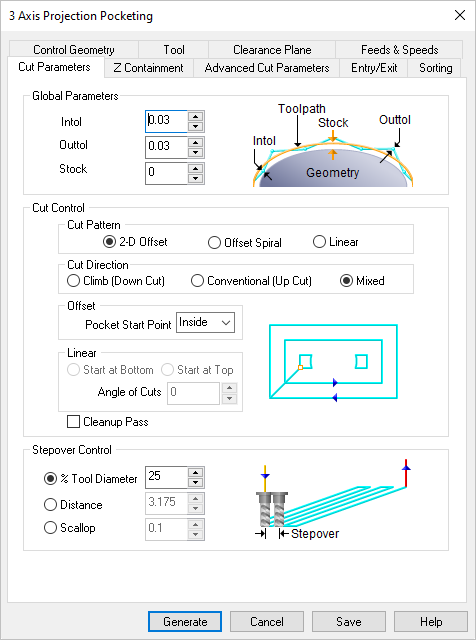 Dialog Box: Cut Parameters tab, Projection Pocketing, 3/4 Axis |
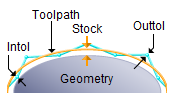 Global Parameters, 3 Axis Operations The Global Parameters section allows you to set the tolerance value to be used in machining. Intol and Outol are allowable deviations (tolerances) from the actual part geometry plus the Stock layer (if any). A uniform thickness or stock that needs to be left around the part can be specified here.
Intol / Outol
Inward tolerance - the maximum thickness of material that can be removed from the Stock layer. Outward tolerance is the maximum thickness of material that can remain above the Stock layer.
 Tolerances play a vital role in both design engineering and digital manufacturing. In design, the goal is to allow the broadest tolerance range possible while meeting your design specifications. This is because, generally speaking, there is a direct correlation between tighter tolerances and higher manufacturing costs. Tolerances play a vital role in both design engineering and digital manufacturing. In design, the goal is to allow the broadest tolerance range possible while meeting your design specifications. This is because, generally speaking, there is a direct correlation between tighter tolerances and higher manufacturing costs.
Read the full article...
|
|
Stock
The thickness of the layer that will remain on top of the part after the toolpath is complete. Roughing operations generally leave a thin layer of stock, but for finishing operations this value is zero.
|
2-D Offset
This is a pocketing pattern derived from the stock geometry.
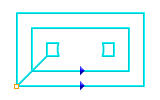 Stock Offset (Pocketing) Offset Spiral
Select Offset Spiral and the tool will traverse in a spiral pattern with successive offsets of the part shape starting from the Inside or Outside depending on the Start Point selection.
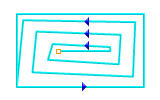 Offset Spiral Linear Cuts
Select Linear and the tool will traverse in a Linear cut beginning at the Top or Bottom depending on the Start Point selection.
 Linear
|
This can be controlled by specifying either Climb (Down Cut), Conventional (Up Cut) or Mixed.
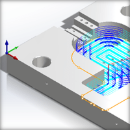 One of the basic concepts to understand in any milling operation is Cut Direction. It can be characterized by how the flutes of the cutting tool engage the stock material and form the chip that is removed during cutting. In many of MecSoft CAM’s 2½ & 3 Axis toolpath strategies you will see that Cut Direction is defined by selecting one of three options, Climb, Conventional or Mixed. Let’s take a look at the characteristics of each option. One of the basic concepts to understand in any milling operation is Cut Direction. It can be characterized by how the flutes of the cutting tool engage the stock material and form the chip that is removed during cutting. In many of MecSoft CAM’s 2½ & 3 Axis toolpath strategies you will see that Cut Direction is defined by selecting one of three options, Climb, Conventional or Mixed. Let’s take a look at the characteristics of each option.
Read the full article...
|
|
|
Pocket Start Point can be set to inside or outside. This is applicable for Part offset and Stock Offset cut patterns.
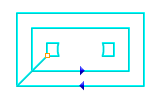 Inside |
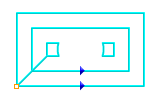 Outside |
|
The Linear controls are only enabled when Cut Pattern (see above) is set to Linear. Select from the following:
Start at Top / Start at Bottom
Allows you to specify the start point for the Mixed cut pattern.
Angle of Cuts
Allows you to specify the Angle of the Mixed cut pattern.
Cleanup Pass
Check this option to cause automatic detection of all the corners that the tool could not reach between each pass. It will then add a toolpath based on the uncut area detected; either a linear cut in case of smaller areas or a cut that travels along the shape of the uncut area, when the area is large. This is applicable for Linear cut patterns.
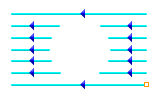 Cleanup Pass unchecked |
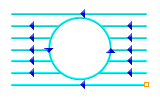 Cleanup Pass checked |
|
|
 Stepover Control, 3 Axis Operations This allows you to define the spacing between the cuts. Select from the following options:
% Tool Diameter
Enter the stepover distance as a percentage value of the tool diameter.
Distance
Enter the exact stepover distance preferred.
Scallop
(not available for all operations)
Enter the scallop height to determine the spacing between cuts.
|







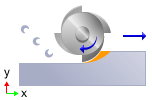
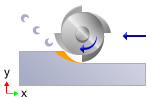
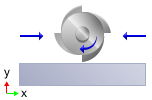
 One of the basic concepts to understand in any milling operation is
One of the basic concepts to understand in any milling operation is 


